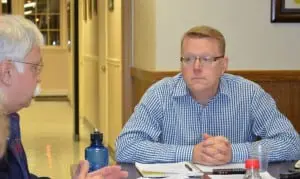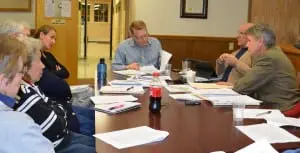Gallagher sticks to position through combative session
By Jeanne Tao
On Monday, Oct. 8, the Cold Spring Village Board and the Historic District Review Board (HDRB) met with Julian Adams of the New York State Historic Preservation Office (NYSHPO). Adams is community liaison coordinator, charged with helping local governments with historic preservation efforts. He has written local laws on historic preservation and was called by both boards to help them interpret the Village Code and come to an understanding on the role of the HDRB.

Looming over the session was the issue of the preservation of the Butterfield Hospital building, defunct for 23 years, and plans by the developer, Paul Guillaro of Butterfield Realty LLC, to demolish the building in order to construct a space for the post office, intergovernmental municipal offices, a senior-citizen center, retail-commercial space, market-rate condominiums for retirement-age buyers, and single-family houses.
Mayor Seth Gallagher has tried to speed the process for the development in order to keep the post office, whose extended lease will expire at the end of November, in the village.
If he had hoped to have Adams on his side of the argument, Gallagher must have been disappointed by the outcome of the almost 3-hour-long meeting. His comments the following evening (Oct. 9) at the regular meeting of the Village Board pointed to continued disagreement with Adams and the HDRB.
Interpreting the code
The village attorney, Steven Gaba, who had presented his interpretation of the code at earlier meetings, was not present on Monday, which was the Columbus Day holiday. Gaba’s legal opinion served as the basis for Gallagher’s understanding of the code, put forth at the last Village Board meeting on Sept. 25: that the HDRB is overstepping its role and using criteria designed for one purpose — the designation of a landmark or expansion of the historic district (section 64-6 of the code) — to make decisions on applications to alter existing structures, which requires looking solely at exterior architectural features that contribute to historic character (64-7).
It would become clear through the course of the meeting that Adams did not agree with Gaba’s interpretation. In his opinion, the code necessitates the use of those criteria for making decisions on certificates of appropriateness, since those criteria are assumed to have been used to create the historic district in the first place.
Proper procedure
From the boards’ narrative of the Butterfield development’s applications, Adams heard that Guillaro had withdrawn his first plan earlier this year in frustration as a result of incomplete understanding of the process of applying to build within the historic district. This misunderstanding was compounded, not only for the developer, by earlier experiences in the village, in which the demolition of a derelict lumberyard for a development was accelerated and desired by all boards.

Adams expressed surprise upon hearing also that Guillaro had said he did not want to go through the lengthy process of obtaining a certificate of economic hardship, which Adams explained later should be the primary method of obtaining permission to demolish a building in the historic district according to Cold Spring’s current code.
As the narrative progressed, so tension and disagreement increased between the mayor and the HDRB. Whether quibbling over details or arguing over what someone said or didn’t say, Gallagher found himself at odds with many around the table, including Adams and Village Board Trustee Matt Francisco. Adams, meanwhile, sick and on cold medication, was clearly eager to keep the meeting moving towards closure.
Time and time again, Adams attempted to steer the discussion to the code, which he agreed had faults but which was still the law. “There’s a process to go through here so that people don’t get rankled,” he explained.
One of the faults of the code, according to Adams, was that it had not officially adopted any survey of the historic district and thus did not point to contributing or non-contributing characteristics of buildings as criteria for any decision-making. In this code, he iterated over and over, all buildings within the district would be treated equally as part of the fabric of the district.
“Tacitly, everything is contributing [to historic character] right now in the district,” he said. An application for a certificate of appropriateness for complete demolition of a structure is “typically an automatic denial.” Anyone with plans for demolition must be issued a certificate of economic hardship in order to proceed. “The whole code is about retaining the building,” he said. In his extensive preservation experience, he found that “demolition is handled 100 percent, across every preservation code, in the hardship procedure.”
Demolition vs. alteration
A discussion ensued over whether complete demolition of a building constituted an “alteration” in the code. Gallagher argued that the code only mentions “alteration,” and if complete demolition is not included as an alteration, then complete demolition is not within the purview of the HDRB.
“Why don’t we just take a bulldozer to all of Main Street then?” Adams exclaimed. He defended the HDRB’s role in slowing down processes such as the proposed demolition of buildings in the historic district. He stated that while complete demolition is absent from the chapter altogether, it implies that all structures must be preserved, in its essence as historic preservation law.
Francisco, the Village Board’s HDRB liaison, added that this was the danger in having Gaba, who was not an expert in preservation law, look at the code. Gallagher dismissed this, saying, “No, it isn’t a danger.” Francisco countered, “It is, Seth. It is. … I think a preservation attorney would look at this and say, the chapter has an intent, has a spirit to preserve.”
On whether the HDRB could use the criteria outlined in 64-6 of the code to determine whether a plan to alter a building should be given a certificate of appropriateness (64-7), Adams said it could, because section J of 64-6, what he called the smoking gun, states that the historic district is “confirmed to meet the criteria set forth above.”
While Gallagher and HDRB member Kathleen Foley argued over these criteria, over two hours into the meeting, Adams called for a timeout. “We’ve got two sides of the table that I’m hearing. You [the HDRB] want it saved; you [the mayor] want it down.”
“No,” protested Gallagher repeatedly, eventually being shushed by Foley while Adams spoke.
Recommendations
Attempting to draw the meeting to a close, Adams recommended that they hold workshops through a grant with the NYSHPO to revise the current law “to bring it up to modern standards, which should address some of these issues,” and then try to obtain another grant to conduct a survey that they could adopt. As for the Butterfield project, he advised, “Go ahead and get the application in and make a decision on it. That sets up the next step, by your code.”
Gallagher said the HDRB should run the decision by an attorney if it cited the contested set of criteria.
Francisco concluded that the developer could be granted a certificate of appropriateness, avoiding the economic hardship process, if the plans preserved parts of the building in a new application. Al Zgolinski, the HDRB chairman, then spoke about preserving the 1963 addition to the building, but Francisco pointed out that, since the style of the two earlier parts of the building was Colonial Revival, the 1960s addition would not contribute to the building’s character. Zgolinski tried to make a case for the 1963 addition due to its link to community members and wall plaques for donors.
Aftermath
At Tuesday’s meeting of the Village Board, Gallagher responded to a liaison report written by the HDRB and presented by Francisco, which summarized Monday’s meeting with Adams. Gallagher called Adams’ interpretation of the code “odd” and described some of his statements as “strange” and contradictory, referring to the issue of complete demolition not being defined as an alteration.
He also called the HDRB’s report “wacky” and downplayed the importance of Adams’ opinions, since he is not an attorney. When asked by the mayor for his take on the situation, Gaba said he would have to listen to the recording of the meeting before making any statements.
In a release Thursday morning, Gallagher announced he was appointing Trustee Bruce Campbell to replace Francisco as liaison to the HDRB.

